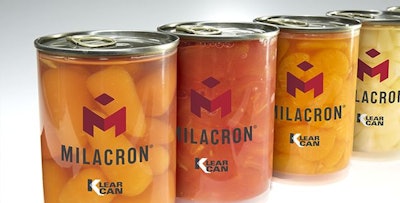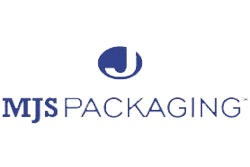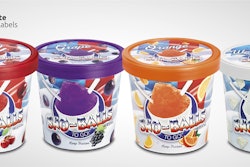
In a new market report, “The Future of Rigid Plastic Packaging to 2022,” Smithers Pira forecasts that global rigid plastic packaging consumption will be worth $166 billion in 2017, and exceed $200 billion at the end of its study period in 2022. Volume consumption of rigid plastics globally will reach 52.9 million tonnes in 2017, and is projected to grow over the next five years at an annual rate of 3.7% to 63.4 million tonnes.
According to the report, rigid plastic packaging market expansion will continue to profit from the drive to replace traditional materials—principally glass and metal—with lighter-weight, more cost-effective and higher performance plastic materials in various markets. This transition is being accelerated by concept innovations, such as the clear plastic can. Developed by U.S.-based Milacron, the Klear Can technology is aimed at transforming the canned food preservation industry, saving weight and allowing a better display of premium tinned goods on supermarket shelves.
Despite these opportunities, this packaging segment is also dealing with challenges. None of these is more disruptive than the emergence of flexible packaging and the growing importance of sustainability.
The importance of sustainability
Sustainable packaging is an overarching megatrend with particular implications for the rigid plastic packaging industry. There is mounting public pressure on brand owners and retailers to reduce the environmental impact of their packaging. The response has been to address package via:
- Light-weighting—reducing material usage without impairing pack performance
- Increased use of recycled plastic feedstocks
- Investigating the use of bioplastic packaging
Brand owners are employing more recycled and recyclable plastic packaging to reduce the environmental impact of packaging. Bioplastics are a popular choice for brand owners that seek to showcase their environmental credentials more demonstrably. In practice, the different approaches can be combined.
For example, Unilever announced in January 2017 that it has committed to ensuring that all of its plastic packaging is fully reusable, recyclable, or compostable by 2025. The company had already committed to reducing the weight of its packaging this decade by one-third by 2020, and increase its use of recycled plastic content in its packaging to at least 25% by 2025.
Companies across many end-use segments are increasingly recognizing that sustainability in packaging is a core value, rather than a one-off sales and marketing opportunity, while retailers are now offering biodegradable packaging for a wide range of produce, including fresh foods, and organic and private-label brands.
Emerging technology
Technology is playing an important role in rigid plastic packaging market development as it competes with rival packaging types. Several of these directly affect the environmental impact of the pack or product inside:
- Bio-based plastics, including 100% bio-based PET bottles, are expected to enter commercial production and establish significant market share over the next five years
- Producers have developed considerably lighter plastic packaging in recent years and opportunities remain for further lightweighting of plastic packaging
- Improved barrier solutions enable further penetration of rigid plastic packaging into applications such as fruit juices, milk, wine, and hot-fill food jars, reducing emissions during transport.
From a marketing perspective, the further penetration of digital (ink-jet and toner) printing systems for beverage bottles and new concepts like no-look and interactive labels are pushing innovation in key segments, such as PET carbonated soft drink bottles.
Rigid plastics versus flexible
Rigid plastic packaging is under growing threat from flexible plastic packaging formats. Over the last decade, rigid pack formats across various end-use applications have been gradually replaced by flexible packaging types.
The flexible packaging industry is promoting more of the “pre-cycling” benefits of their packages versus rigid packaging as the combination of environmental pressures and uncertain polymer prices persist. Flexible packaging uses fewer resources and less energy than rigid polymer formats. This equates to significant reductions in packaging costs, materials use, and transport emissions, as well as some performance advantages over rigid packaging.
Stand-up pouches, for example, are lighter-weight and have lower material use compared with rigid containers. The heat-resistant retort stand-up pouch is made of laminated plastic films, or foil, if microwaving is not required.
Packaging designers are investigating new features, such as handles, and fixtures, such as child-proof caps, to challenge rigid formats, creating a corresponding desire for pack differentiation in the rigid plastic segment.
The figures
From a regional perspective, emerging economies are expected to grow rigid plastic packaging demand at the highest rates across 2017-2022.
Asia is already the largest consumer of rigid plastic packaging, accounting for a projected 31.4% consumption share by volume in 2017. North America is the second largest consumer with 22.7%, followed by Western Europe with 20.0%. Asia is forecast to continue growing at a faster rate than any other world region with an annual average growth rate of 5.8% for the next five years.
Food is the largest end-use market for rigid plastic packaging, accounting for a projected 37% consumption share in 2017. The healthcare sector is forecast to grow at the highest rate, followed by other food markets, drinks, and cosmetics.
Lifestyle and demographic influences
Demographic trends, translating into new demands and expectations of packaging are key to driving the selection of packaging formats. A high rate of population growth is more likely to be associated with growing packaged product consumption. The age structure of the population also plays an important role. For example, aging populations in advanced economies and better medical provision in developing countries will fuel increased demand for healthcare products.
Lifestyle factors such as the rise of single-portion meals and on-the-go consumption can also favor lighter plastic formats, especially for small convenience pack sizes.

























